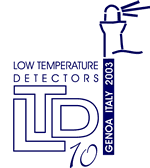|
Tapestries and frescoes
Though
austere on the outside, Genoa's patrician houses were and still are
luxurious on the inside: stucco and gilt, frescoes and hangings expressed
their owners' power. Genoa was one of the first European cities to import
fabrics and tapestries from the Orient. Later, the richer houses were
embellished with furniture, silverware and fabric produced by the extremely
talented local craftsmen. Frescoes on the vaulted ceilings of Genoese
salons borrowed from both mythology and local history to celebrate the
feats of the owners and their families.
Even
today, villas and palaces still bear witness to an extraordinary era,
nearly two whole centuries, with major Genoese painters such as Cambiaso,
the Piolas, Tavarone, the De Ferraris, Guidobono and Strozzi. To get
an idea of the heights reached by the decorative arts in Genoa, just
look at the many churches (Annunziata, San Siro, Santa Croce) or the
palaces open to the public (the Banco di Chiavari building and the Palazzo
Rosso in viaGaribaldi).
|
|
|
The family palaces
Genoa's
houses were built of wood until the 13th century. And there was a public
official, the "Cintraco" who went round the various quarters
on days when there was a "kite wind", warning people of the
risk of fire. Later, when houses were built of bricks, they rose to
four or five storeys and the roofs were made of slate from Lavagna.
Then the mediaeval houses changed their aspect with Renaissance ornament,
especially the portals that closed off the ground floor loggias to make
public spaces private, to enliven courtyards and make entrance halls
ring with familiar voices.
The spirit of the 16th century culminated in the Strada Nuova, later
via Aurea and finally via Garibaldi, one of the most splendid streets
in Europe, with such austerely magnificent buildings as Palazzo Lercari,
Palazzo Spinola, Palazzo Bianco, Palazzo Tursi-Doria (City Hall) and
Palazzo Rosso.At the beginning of the 17th century the spectacle was
repeated in the Strada Grande del Guastato (today's via Balbi). For
Madame de Stael the buildings in this road were "fit for a congress
of Kings". And in fact, they have just recently welcomed a very
special tourist: Elizabeth II of England.
|
|
|
The Villas
Genoa's
enviable climate is largely due to the hills and mountains shelter her.
This made it possible for Genoese families to find holiday resorts close
to the city and to build splendid country houses there. Some of these
were fairly well known even before opening to the public, but the vast
majority were a completely closed book, so that when they eventually
became the property of the city, they were a great revelation even for
the Genoese themselves.
Among the better known is the magnificent Villa Cambiaso, with its beautiful
park and sports facilities, and Villa Gambaro, both in the Albaro quarter.
At Nervi, Villa Serra which stands in one of Italy's finest parks, close
by to Villa Luxoro and Villa Gropallo. Back in the centre, we have Villa
Imperiale at San Fruttuoso, Villetta Dinegro and Villa Croce.
Lastly, on the western side, Villa Durazzo Pallavicini (with its spectacular
jeux d'eau), Villa Scassi at Sampierdarena, Villa Rossi at Sestri Ponente
and Villa Duchessa di Galliera at Voltri, with its famous English style
park.
|
|
|
|
Museums
Masterpieces
by Rubens and Caravaggio, the exotic splendours of Oriental art, curios
from the remotest corners of the globe. The discerning art lover will
find Genoa's museums of extreme interest, and in some ways even unique.
To begin with the best known and most copious, the galleries in Palazzo
Rosso and Palazzo Bianco, the two historic buildings opposite
one another on via Garibaldi (jewel of Renaissance urban development).
Palazzo Rosso houses works by the major Genoese painters, as
well as Van Dyck Titian and Veronese. Palazzo Bianco pays splendid
tribute to the city's international links in the 17th century with works
by Genoese, Flemish and Dutch masters, including Cambiaso, Strozzi,
Magnasco, Rubens, De Wael, Van Der Goes, Jan Metsys, Cranach, Teniers
and Zurbaran. Villetta Dinegro, standing on a slight rise above
piazza Corvetto, has a recently built annex those houses one of the
richest collections of Oriental art in Europe. Its 15,000 items
span a thousand years of Japanese art, collected in the 19th century
by Edoardo Chiossone (painter and director of the Japanese Mint)
after whom the museum is named Local history, on the other hand, can
be happily investigated in the "Museo del Tesoro di San Lorenzo"
in the Cathedral crypt, where the architect Albini designed a special
exhibition facility. Albini 's last work is the highly impressive Museum
of Ligurian Sculpture and Architecture in the recently restored
and restructured Sant'Agostino complex in piazza Sarzano. For archaeologists
there is the Museum of Archaeology (via Pallavicini, 11). Another
repository of local history is the Galleria di Palazzo Reale,
in via Balbi. This valuable collection also features works by Van Dyck,
Reni, Tintoretto and Guercino.
The Santa Maria di Castello Convent - with possibly the oldest
church in Genoa - houses a museum with works by Brea and Maragliano.
An absolute must for those visiting a city that was once one of the
most powerful maritime republics in history is the Maritime Museum
(Villa Doria, piazza Bonavino, 7). Here, a big collection of navigational
instruments
includes one of the four surviving astrolabes made by Ignatio Danti,
the great 16th century cosmographer.
The Museo Americanistico Lunardi (Corso Solferino, 39) specializes
in Pre-Columbian art and has the richest collection of Maya art in Europe.
Theatregoers should visit the "Museo Biblioteca dell'Attore"
on the site of a building left to the city by Adelaide Ristori (via
IV Novembre, 4). To come back to Pre-Columbian civilizations, there
is a Museum of Ethnology in the Castello D'Albertis (Corso Dogali,
18). Natural history enthusiasts should visit the Museo Giacomo Doria
(via Brigata Liguria, 9).
To investigate the history of the city, its culture and tastes, there
is no lack of material: the "Museo del Risorgimento"
and the "Istituto Mazziniano" in the birthplace of
G. Mazzini, founder of "Giovine Italia" (via Lomellini); the
Galleria D'Arte Moderna in Villa Serra (via Capolungo), which offers
an illuminating study of fin de siecle Genoa on the canvases of local
artists; the museum in Villa Luxoro (set in a charming park in
Nervi) boasts a fine collection of antique furnishings and objects d'art,
as well as a picture gallery; the "Museo dell'Accademia Ligustica
di Belle Arti" (Ligurian Fine Arts Museum), founded by a group
of wealthy and enlightened Genoese in 1751, spans more than five centuries
of figurative art in Genoa and Liguria up to the last century.
Special mention must be made of the National Gallery in Palazzo Spinola
(piazza Pellicceria). This aristocratic town house is perfectly preserved
and contains a priceless collection of furnishings and paintings (Antonello
da Messina, Van Cleve, Van Dyck) We should not forget the "Museo
di Villa Croce", a visual arts centre of contemporary art,
hosting important collections of abstracts artists.
|
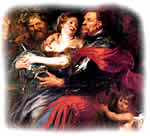
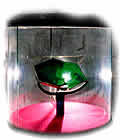
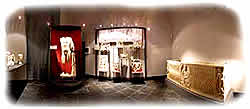
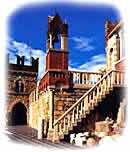
|
|
A new Genoa
Genoa
was built, as the poet Paul Valery observed, "in a continual struggle
with the mountain". The centuries of work that produced today's
city began in pre-historic times on the Castello hill, where the charming
church of Santa Maria still stands. Genoa as we would recognize it first
appeared in the 13th century.
In the 19th century radical urban development gave Genoa a new centre
and extended the city beyond the outer walls. Industrialization favoured
a process of amalgamation, with the various suburbs ("delegazioni")
being administratively joined in 1926 to form a Greater Genoa. A city
with two souls, Genoa offers both unsuspected art treasures and one
of Europe ' s most advanced, complex and comprehensive services structures.
In recent years urban development has redrawn the architectural geometry
and managed to create spectacular effects without in the least compromising
Genoa's historic heritage.
The Expo gave back the city her old harbour, now completely renovated,
with the new convention centre in the Cotton Warehouses forming a splendid
centrepiece. One of the most advanced structures in Europe, this development
follows on from similarly successful projects, including the Fiera del
Mare congress facility, the World Trade Centre and the Sant'Andrea abbey.
On the eve of 2000, Genoa is consolidating its reputation as a top congress
venue. For several reasons: apart from the enviable climatic and environmental
conditions, the location is well served by motorways and an airport
and has excellent accommodation facilities including brand new hotels
and country houses available for meetings and banquets.
Further space has been found thanks to the brilliant restoration projects
regarding Genoa's most illustrious monuments. In piazza San Matteo,
the church has been restored along with a number of Doria buildings,
one of which is the venue to major exhibitions. Not far off is the huge
mass of the Palazzo Ducale, which has been converted into a highly prestigious
cultural "shell" for exhibitions, conventions and conferences.
Another conference facility is the auditorium in the recently rebuilt
Carlo Felice Opera House, one of Italy's greatest theatres. Entertainment
space has also been created in the towers of Corte Lambruschini, a new
office development that, with San Benigno, represents a focal point
of business interests in Genoa today.
|
|
|
From mountain-side to sea-front
To
follow the valleys down to the sea is also to discover a wealth of art
treasures in Genoa's hinterland, from the scattered villages of the
Apennines to the numerous fishing villages along the coasts. A good
place to start is Masone, with its Iron Working Museum, in the Stura
valley. Campo Ligure has a Filigree Museum and a renovated castle, which
hosts exhibitions and other public events. Rossiglione is noted for
its churches (Santa Caterina and Nostra Signora Assunta). The upper
Orba valley, on the other hand, was under the "protection"
of Tiglieto abbey for nearly 900 years and is now private property.
Campomorone has a museum of paleontology and mineralogy in the 16th
century Palazzo Balbi. Nearby, on Mt. Figogna is the Madonna della Guardia
sanctuary. The main centre in the Scrivia valley is Busalla, with its
richly verdant park and nympheum. On the banks of the Scrivia lies Ronco
Scrivia, where there is a local history musem.
A few kilometres, on Isola del Cantone, with the outstanding pinola-Mignacco
castle. Another castle, "Pietra", stands over the river on
the road to Vobbia At Crocefieschi, remains of the old Fieschi manor
can still be seen. The Santa Croce parish church has paintings and wooden
statues. At Savignone too the ruins of the feudal castle remain, together
with the Baroque church. At Casella, paintings by G.Andrea Ferrari can
be admired in the church of Santo Stefano. Beyond Montoggio (where the
church has well-preserved paintings by the Genoa school) are Torriglia
and the upper valley. Along Val Trebbia are Montebruno (Santuario della
Madonna) and Fontanigorda (San Rocco chapel). Not to be missed are the
ancient copper mine (10th cent.) and the museum of rural culture.
There is much to see on the coast too: the parish churches of Cogoleto
and Arenzano, and not far, on a hill, the fascinating Santuario del
Bambin Gesù di Praga. East of Genoa there are splendid Baroque
churches at Bogliasco and Sori and the ancient church of San Michele
at Pieve Ligure Alta. The nearby oratory contains wooden crucifixes
of the Genoa school.
|
|
